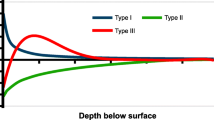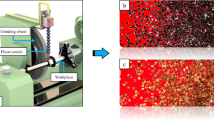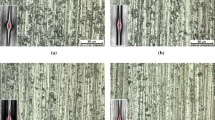Abstract
An abrasive machining process, such as grinding, sometimes is the most suitable option when component surfaces demand specific requirements as tight tolerances of shape and dimension. Austempered ductile iron (ADI) is a material used in a wide variety of components. The expansion of existing knowledge about the methodology with which ADI is produced has allowed to develop parts with shapes and dimensions close to the final ones. Due to this, components with sections of different thicknesses, which could include thin walls, are becoming more common. Nevertheless, scarce information about ADI straight surface grinding can be found in works both recent and preceding. This research seeks to analyze the influence of the cutting parameters and the microstructure features on surface finish and surface integrity in thin wall ADI samples subjected to straight surface grinding. Specific cutting energy consumed during grinding was quantified, their surface roughness was measured, and microdeformations at different scales were determined to study the mechanical effect associated with the generation of residual stress (RS). In order to estimate the RS profile shape and magnitude from the distortion produced in the specimens, a previously established relationship between distortion and RS formation was applied.














Similar content being viewed by others
References
Marinescu ID, Rowe WB, Dimitrov B, Inasaki I (2012) Tribology of abrasive machining processes, 2nd edn. William Andrew Publishing, New York
Rowe BW (2013) Principles of modern grinding technology, 2nd edn. Elsevier Inc, Oxford
Tao Z, Yaoyao S, Laakso S, Jinming Z (2017) Investigation of the effect of grinding parameters on surface quality in grinding of TC4 titanium alloy. Procedia Manufact 11:2131–2138. https://doi.org/10.1016/j.promfg.2017.07.344
Liu Z, Deng SY, Wan L (2017) Effects of grinding parameters on surface quality in silicon nitride grinding. Ceram Int 43:1571–1577. https://doi.org/10.1016/j.ceramint.2016.10.135
Miao Q, Ding W, Kuang W, Yang C (2020) Comparison on grindability and surface integrity in creep feed grinding of GH4169, k403, DZ408 and DD6 nickel-based superalloys. J Manuf Process 49:175–186. https://doi.org/10.1016/j.jmapro.2019.11.027
Chaudhari A, Awale AS, Chakrabarti AK (2019) Surface integrity characterization of austenitic, martensitic and ferritic stainless steel under different grinding process. Mater Res Express 6:1165c9. https://doi.org/10.1088/2053-1591/ab4f22
Da Silva R B, Lima MLS, Pereira MF, Abrão BS, Da Silva LRR, Bianchi EC, Machado AR (2018) A surface and sub surface quality evaluation of three cast iron grades after grinding under various cutting conditions. Int J Adv Manuf Technol 99:1839–1852. https://doi.org/10.1007/s00170-018-2628-z
De Martini Fernandes L, Lopes JC, Volpato RS, Diniz AE, De Oliveira RFM, de Aguiar PR, De Mello HJ, Bianchi EC (2018) Comparative analysis of two CBN grinding wheels performance in nodular cast iron plunge grinding. Int J Adv Manuf Technol 98:237–249. https://doi.org/10.1007/s00170-018-2133-4
Sosa AD, Echeverría MD, Moncada OJ, Sikora JA (2006) Residual stresses, distortion and surface roughness produced by grinding thin wall ductile iron plates. Int J Mach Tools Manuf 47:229–235. https://doi.org/10.1016/j.ijmachtools.2006.04.004
Associazone Italiana Fonderie (2019) .. In: Fonderia 5. https://www.assofond.it/documents/20142/57050/In_Fonderia_+5_2019.pdf/ (Accessed August 2021)
Nofal A (2013) Advances in the metallurgy and applications of ADI. J Metallurgic Eng 2(1)
Kim YJ, Shin H, Park H, Dae Lim J (2008) Investigation into mechanical properties of austempered ductile cast iron (ADI) in accordance with austempering temperature. Mater Lett 62:357–360. https://doi.org/10.1016/j.matlet.2007.05.028
Górny M, Tyrala E (2013) Effect of cooling rate on microstructure and mechanical properties of Thin-Walled ductile iron castings. J Mater Eng Perform 22(1):300–305. https://doi.org/10.1007/s11665-012-0233-0
Mourad MM, Ibrahim KM, Ibrahim MM, Nofal A (2008) Optimizing the properties of thin wall Austempered Ductile Iron. 68th World Foundry Congress, 161–166
David P, Massone J, Boeri R, Sikora J (2004) Mechanical properties of thin wall ductile iron influence of carbon equivalent and graphite distribution. ISIJ Int 44:1180–1187. https://doi.org/10.2355/isijinternational.44.1180
Borrajo JM, Martinez RA, Boeri RE, Sikora JA (2002) Shape and count of free graphite particles in thin wall ductile iron castings. ISIJ Int 42:257–263. https://doi.org/10.2355/isijinternational.42.257
Benini L, Weingaertner WL, Uhlmann E (2015) Grinding of austempered ductile iron grade 3 as function of the Microcrystalline Al2O3 Grinding wheels composition. Adv Mater Res 1105:164–171. https://doi.org/10.4028/www.scientific.net/AMR.1105.164
Sosa AD, Echeverría MD (2015) Surface alterations produced in grinding of austempered ductile iron. Procedia Mater Sci 8:155–161. https://doi.org/10.1016/j.mspro.2015.04.059
Furno ME, Sosa AD (2020) Surface integrity analysis of grinding on ductile iron. Int J Adv Manuf Technol 110:2067–2078. https://doi.org/10.1007/s00170-020-05873-y
Massone JM, Boeri RE, Sikora JA (2003) Solid state transformation kinetics of high nodule count ductile Iron. Int J Cast Metals Res 16:179–184. https://doi.org/10.1080/13640461.2003.11819579
Oberg E, Jones FD, Horton HL, Ryffel HH (2004) Machinery’s handbook, 27th edn. Industrial Press, New York
Zarudi I, Zhang LC (2002) Modelling the structure changes in quenchable steel subjected to grinding. J Mater Sci 37:4333–4341. https://doi.org/10.1023/A:1020652519141
Rowe WB, Chen X (1997) Characterization of the size effect in grinding and the sliced bread analogy. Int J Product Res 35(3):887–899. https://doi.org/10.1080/002075497195768
Heinzel C, Bleil N (2007) The use of the size effect in grinding for work-hardening. CIRP Annals 56(1):327–330. https://doi.org/10.1016/j.cirp.2007.05.075
Tricard M (1996) Residual effects of finishing methods. In: ASM Handbook Volume 5: Surface Engineering, second printing. ASM International. Norton Company. https://doi.org/10.31399/asm.hb.v05.9781627081702
Shaw MC (1996) Principles of abrasive processing. Oxford Science Publications, New York, pp 4–5
Totten G, Howes M, Inoue T (2002) Handbook of residual stress and deformation of steel, 1st edn. ASM International, Netherlands
Malkin S, Guo C (2007) Thermal analysis of grinding. CIRP Ann 56(2):760–782. https://doi.org/10.1016/j.cirp.2007.10.005
Smallman RE, Ngan AHW (2014) Modern physical metallurgy, 8th edn. Butterworth-Heinemann by Elservier, Oxford
Hamdi H, Zahouani H, Bergheau JM (2004) Residual stresses computation in a grinding process. J Mater Process Technol 147:277–285. https://doi.org/10.1016/S0924-0136(03)00578-8
Acknowledgements
The authors would like to thank Universidad Nacional de Mar del Plata and CONICET for the funding, and to Dr. Eng. Flavio Soldera from Dept. Materials Science & Engineering of Saarland University for his collaboration.
Funding
Universidad Nacional de Mar del Plata and CONICET
Author information
Authors and Affiliations
Corresponding author
Ethics declarations
Conflict of interest
The authors declare no competing interests.
Additional information
Availability of data and material
The manuscript has no associated data or the data will not be deposited
Publisher’s note
Springer Nature remains neutral with regard to jurisdictional claims in published maps and institutional affiliations.
Rights and permissions
About this article
Cite this article
Furno, M.E., Sosa, A.D. Effect of grinding parameters and microstructural features on surface integrity of ADI ground components. Int J Adv Manuf Technol 117, 2959–2971 (2021). https://doi.org/10.1007/s00170-021-07851-4
Received:
Accepted:
Published:
Issue Date:
DOI: https://doi.org/10.1007/s00170-021-07851-4




